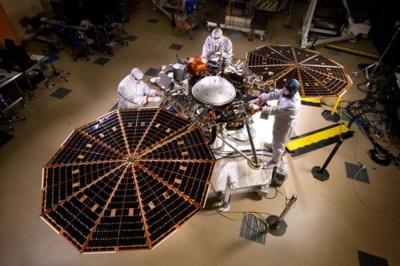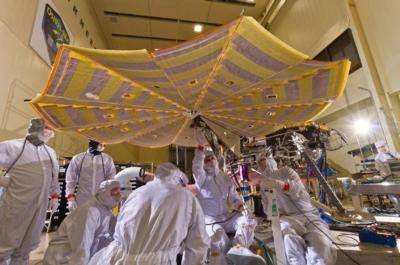InSight Lander Will Study The Planet's Interior Structure
Testing is underway on NASA’s next mission on the journey to Mars, a stationary lander scheduled to launch in March 2016.

The lander is called InSight, an abbreviation for Interior Exploration using Seismic Investigations, Geodesy and Heat Transport. It is about the size of a car and will be the first mission devoted to understanding the interior structure of the Red Planet. Examining the planet's deep interior could reveal clues about how all rocky planets, including Earth, formed and evolved.
The current testing will help ensure InSight can operate in and survive deep space travel and the harsh conditions of the Martian surface. The spacecraft will lift off from Vandenberg Air Force Base in California, and land on Mars about six months later.
The technical capabilities and knowledge gained from Insight, and other Mars missions, are crucial to NASA's journey to Mars, which includes sending astronauts to the Red Planet in the 2030s.
"Today, our robotic scientific explorers are paving the way, making great progress on the journey to Mars," said Jim Green, director of NASA's Planetary Science Division at the agency's headquarters in Washington. "Together, humans and robotics will pioneer Mars and the solar system."
During the environmental testing phase at Lockheed Martin's Space Systems facility near Denver, the lander will be exposed to extreme temperatures, vacuum conditions of nearly zero air pressure simulating interplanetary space, and a battery of other tests over the next seven months. The first will be a thermal vacuum test in the spacecraft's "cruise" configuration, which will be used during its seven-month journey to Mars. In the cruise configuration, the lander is stowed inside an aeroshell capsule and the spacecraft's cruise stage – for power, communications, course corrections and other functions on the way to Mars -- is fastened to the capsule.

"The assembly of InSight went very well and now it's time to see how it performs," said Stu Spath, InSight program manager at Lockheed Martin Space Systems, Denver. "The environmental testing regimen is designed to wring out any issues with the spacecraft so we can resolve them while it's here on Earth. This phase takes nearly as long as assembly, but we want to make sure we deliver a vehicle to NASA that will perform as expected in extreme environments."
Other tests include vibrations simulating launch and checking for electronic interference between different parts of the spacecraft. The testing phase concludes with a second thermal vacuum test in which the spacecraft is exposed to the temperatures and atmospheric pressures it will experience as it operates on the Martian surface.
The mission's science team includes U.S. and international co-investigators from universities, industry and government agencies.
"It's great to see the spacecraft put together in its launch configuration," said InSight Project Manager Tom Hoffman at NASA's Jet Propulsion Laboratory (JPL), Pasadena, California. "Many teams from across the globe have worked long hours to get their elements of the system delivered for these tests. There still remains much work to do before we are ready for launch, but it is fantastic to get to this critical milestone."
The InSight mission is led by JPL's Bruce Banerdt. The Centre National d’Etudes Spatiales, France’s space agency, and the German Aerospace Center are each contributing a science instrument to the two-year scientific mission. InSight's international science team includes researchers from Austria, Belgium, Canada, France, Germany, Japan, Poland, Spain, Switzerland, the United Kingdom and the United States.
JPL manages InSight for NASA's Science Mission Directorate in Washington. InSight is part of NASA's Discovery Program, managed by the agency’s Marshall Space Flight Center in Huntsville, Alabama. Lockheed Martin Space Systems Company built the lander.
(Images provided by NASA)
 Airbus Racer Helicopter Demonstrator First Flight Part of Clean Sky 2 Initiative
Airbus Racer Helicopter Demonstrator First Flight Part of Clean Sky 2 Initiative Diamond's Electric DA40 Finds Fans at Dübendorf
Diamond's Electric DA40 Finds Fans at Dübendorf ANN's Daily Aero-Term (04.23.24): Line Up And Wait (LUAW)
ANN's Daily Aero-Term (04.23.24): Line Up And Wait (LUAW) NTSB Final Report: Extra Flugzeugbau GMBH EA300/L
NTSB Final Report: Extra Flugzeugbau GMBH EA300/L Classic Aero-TV: 'Never Give Up' - Advice From Two of FedEx's Female Captains
Classic Aero-TV: 'Never Give Up' - Advice From Two of FedEx's Female Captains




